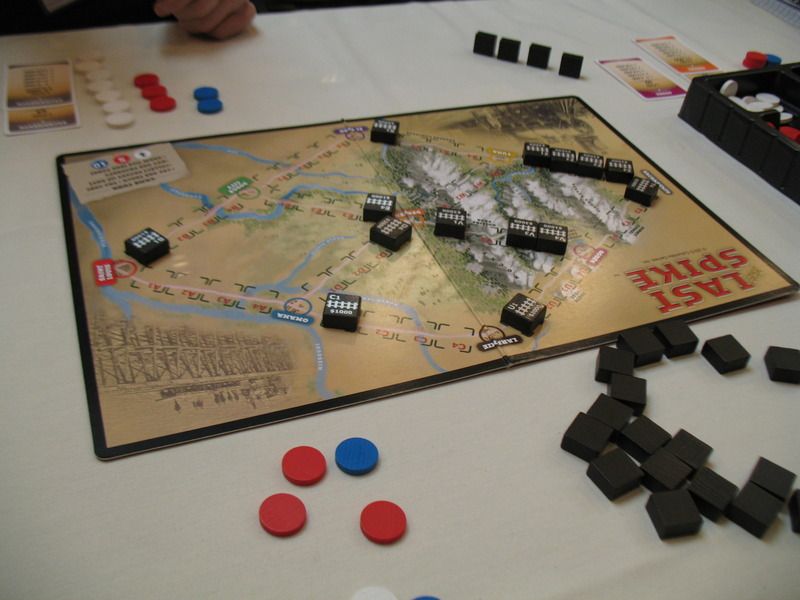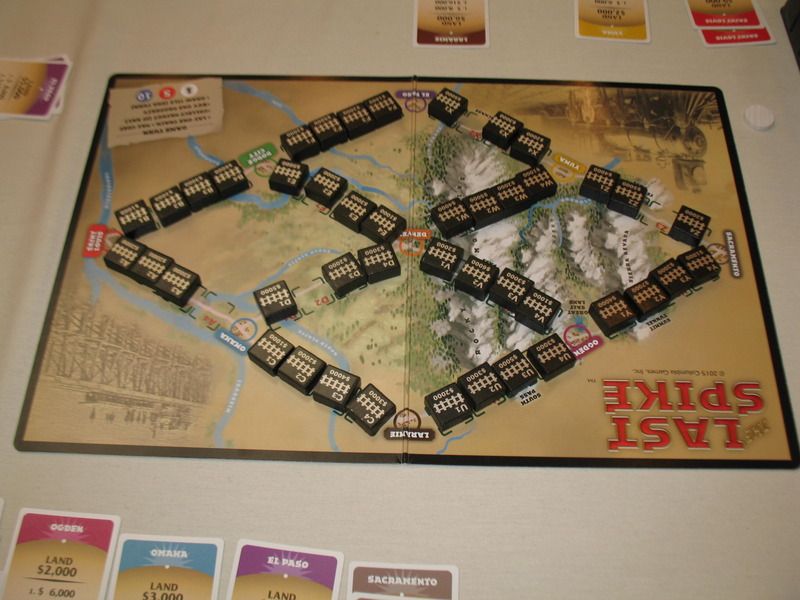 If trends in game design are moving toward getting more with less, The Last Spike would be a case in point. It doesn’t even take five minutes to explain the rules. Playing time clocks in at well short of an hour. And even though this is a strong candidate for the new “go-to” gateway game in town, there’s enough going on with this one that it can still manage to hold the attention of the grognards.
If trends in game design are moving toward getting more with less, The Last Spike would be a case in point. It doesn’t even take five minutes to explain the rules. Playing time clocks in at well short of an hour. And even though this is a strong candidate for the new “go-to” gateway game in town, there’s enough going on with this one that it can still manage to hold the attention of the grognards.
How’s it work?
- On their turn, players pay to play one of their track tiles onto the board. (If the piece is not connected to a city or to preexisting track, the cost is double.)
- If a line between two cities is completed, each of those locations will pay out according to the land cards in players’ possession.
- At the end of your turn, you can buy land from any of the cities that have had track laid next to them. (However, if you were the first to lay track next to a city, you get one there for free.)
- The game ends when Saint Louis and Sacramento are connected. The player that places the last section of track that does this gets a bonus of $20,000.
No, there really isn’t that much to it. Nevertheless, there’s a lot going on in this game. Buy up three or four land cards for a single city and watch what happens. Track will stop getting laid there pretty fast– and the line from Saint Louis to Sacramento has a strong chance of zigzagging around that location altogether. You’re not entirely dependent on your capacity to look like someone your opponents wouldn’t mind helping, though. People will play tiles you wouldn’t otherwise expect to come out in the last several turns of the game. You just have to look like the least worst choice for someone to help out at that point. (Pro tip: quietly palm a couple of your $10,000 tokens when the game is starting to wind down. Yeah, that’s legal.)
And it’s not the case that “whoever gets the most free land will wind”, as I’ve heard people claim. It’s a significant advantage, especially over the guy that’s paying double to lay track in the first few turns. But the payouts are such that the person that can get land in locations that pay out multiple times will more than make up the difference.
Because your hand of tiles are hidden, “real” gamers can play as aggressively as they like without looking like they are singling anyone out. The fact that payouts tend to go several players at once has the psychological side effect of making the completion of each section of track feel like a win-win for nearly everyone. New players are liable to think they have a chance of winning right up until the end and if they do lose, the game is subtle enough that they can blame it on luck without getting discouraged about it. If entertaining non-gamers is something you end up doing a fair bit of, this a title you’ll want to add to your collection. For me, this is just the thing for situations when I’m short on time and want a solid gaming experience anyway. But I like it just as well for its capacity to show non-gamers what’s so appealing about the hobby games scene and also to show aspiring game designers how it’s done.
Recommended.

Please give us your valuable comment